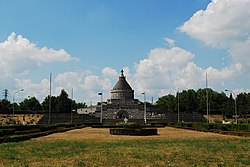Mărășești: Difference between revisions
Content deleted Content added
JJMC89 bot (talk | contribs) Migrate {{Infobox settlement}} coordinates parameters to {{Coord}}, see Wikipedia:Coordinates in infoboxes |
Rescuing 1 sources and tagging 0 as dead. #IABot (v1.6.1) (Balon Greyjoy) |
||
| Line 58: | Line 58: | ||
{{no footnotes|date=November 2015}} |
{{no footnotes|date=November 2015}} |
||
{{commons category|Mărășești}} |
{{commons category|Mărășești}} |
||
* [http://www.vrancea.com.ro/muzeul_vrancei/index.php?id_meniu=2&&id_submeniu=6 Mausoleum of Mărăşeşti] {{ro icon}} |
* [https://web.archive.org/web/20060821142752/http://www.vrancea.com.ro/muzeul_vrancei/index.php?id_meniu=2&&id_submeniu=6 Mausoleum of Mărăşeşti] {{ro icon}} |
||
{{Vrancea County}} |
{{Vrancea County}} |
||
Revision as of 07:21, 29 November 2017
Mărășești | |
|---|---|
Town | |
 | |
| Coordinates: 45°52′48″N 27°13′48″E / 45.88000°N 27.23000°E | |
| Country | |
| County | Vrancea County |
| Status | Town |
| Government | |
| • Mayor | Vlase Constantin (National Liberal Party) |
| Area | |
| • Total | 92 km2 (36 sq mi) |
| Population (2002) | |
| • Total | 13,070 |
| Time zone | UTC+2 (EET) |
| • Summer (DST) | UTC+3 (EEST) |
Mărășești (Romanian pronunciation: [mərəˈʃeʃtʲ]) is a small town in Romania in Vrancea County. It is 20 km (12 mi) north of Focșani. It administers six villages: Călimănești, Haret, Modruzeni, Pădureni, Siretu and Tișița.
History
| Year | Pop. | ±% |
|---|---|---|
| 1930 | 4,532 | — |
| 1948 | 4,940 | +9.0% |
| 1956 | 5,604 | +13.4% |
| 1966 | 6,795 | +21.3% |
| 1977 | 10,521 | +54.8% |
| 1992 | 12,370 | +17.6% |
| 2002 | 13,070 | +5.7% |
| 2011 | 9,440 | −27.8% |
| Source: Census data | ||

King Milan I of Serbia was born in Mărăşeşti on 22 August 1854.
In 1917 during World War I, the Battle of Mărăşeşti between the Kingdom of Romania and the German Empire was fought near the town. A mausoleum containing the remains of 5,073 Romanian soldiers was built to commemorate the Romanian victory.
See also
External links
This article includes a list of references, related reading, or external links, but its sources remain unclear because it lacks inline citations. (November 2015) |
Wikimedia Commons has media related to Mărășești.


